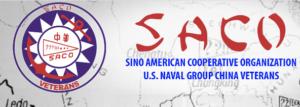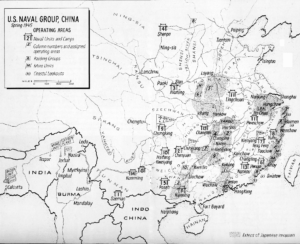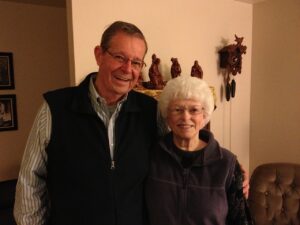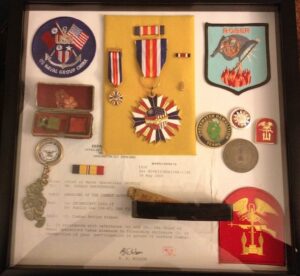SACO’s Secret Work in China
Use controls above or click here to open this Hometown Heroes podcast in a new window
Episode #632 of Hometown Heroes, airing June 11-15, 2020, focuses on a secret unit operating in the China Burma India Theater during World War II, the Sino American Cooperative Organization, or SACO for short.
You’ll hear from one of the Navy’s pioneering “frogmen” who trained in underwater demolition in Ft. Pierce, FL before the advent of the Navy SEAL program. You can learn more about the history of Navy special warfare at the National Navy UDT-SEAL Museum. Of the 2,964 Americans who served behind enemy lines with SACO during World War II, only five were killed, and only three captured. On this episode, you’ll hear from one of the last surviving SACO veterans, Don Hardenbrook of Weiser, ID. The path Hardenbrook followed to his SACO duties was nowhere near a direct one. After convincing his father to sign for his early enlistment into the Navy at age 17, Don went through boot camp in Farragut, ID. Just before the end of his quartermaster training, he was chosen for the V-12 program and sent to Colgate University in Central New York, where he competed on the Raiders’ swim team. After one quarter, an eye test revealed colorblindness, and he was disqualified from becoming an officer. Listen to Hometown Heroes to find out how his softball prowess kept him from being sent to Europe in 1944, and how he ended up instead heading to Florida for training in underwater demolition. Out of 150 men in his 16-week training cohort, Don was one of only 28 to make it through the final cuts.
“We had wool Navy regulation swimming trunks, no flippers, no oxygen,” you’ll hear Hardenbrook explain of their spartan equipment. “We tied nuts and bolts around our waist when we dove.”
Each frogman had to be able to hold his breath for at least two minutes and thirty seconds, and training also included planting explosives underwater. One drill in which they detonated a floating explosive called a “ready fox” resulted in Don and other frogmen being propelled 20 to 30 feet into the air. When his training concluded in Fort Pierce, Don hitchhiked to California, where a ship would take him and other SACO troops from Long Beach to Calcutta, India, then making their way into China.
“We had one thing to do and that was to harass the Japanese,” you’ll hear him say of the effort to keep Japanese forces from controlling Kunming and other SACO outposts. “And we had to train Chinese so they knew how to fight with arms.”
Nearly 100,000 Chinese guerrillas were trained by the SACO units in an effort that reversed military momentum in much of China and produced remarkable results. The joint American/Chinese effort resulted in the destruction of 209 bridges, 84 locomotives, and 141 ships, not to mention tens of thousands of Japanese casualties.

Learn more at the SACO veterans website
You’ll hear Hardenbrook describe how they would take out enemy railroad installations and neutralize enemy patrols, intentionally leaving large geographical separations between clashes with Japanese forces in order to create the illusion of a greater number of troops.
“We did everything on foot,” you’ll hear him explain. “If you finished up and you were 90 or 150 miles away, well then you had to walk night and day until you get back to the base.”
Don and his fellow Americans had to overcome language barriers, working with Chinese combatants who spoke several different Chinese languages. He came away impressed with their courage and the pride they took in defending their homeland. You’ll hear him describe a mission he carried out to completion, only to find out afterwards that Imperial Japan had surrendered two days earlier. A long journey back to Shanghai afterwards included a lengthy stretch in a stolen Japanese ambulance. When the ambulance could take them no further, they had to cover the rest of the distance on foot, arriving in Shanghai for a party attended by Generalissimo Chiang Kai-Shek and his wife.
“I got to dance with Madame Chiang,” you’ll hear Don remember. “I remembered it for the rest of my life, and she probably forgot it as quickly as she could.”




I’m very proud of my grandpa and the work he did in World War II and after the war as well! We are so thankful to have his memories recorded in this way.
Thank you for creating and maintaining this blog post in memory of your father. My father, James Chieh-Ming Dunn, was an early member of SACO starting when he was just 17 years old. Because he had good English (as his father sent him Christian missionary school in Beijing that taught it), my father was recruited by Tai Li and assigned as SACO’S liaison officer with Chinese nationalist forces. By the end of the war, he was a major and because of his smarts and linguistic skills, the youngest adjutant General in the Natl. Chinese army. During the SACO years, my father was a codebreaker working elbow-to-elbow with Joe Gallagher and Thomas Chevala in SACO’s radio intelligence team. After the war ended, my father was one of Gen. George Marshall’s interpreters from 1945-1948 when he was trying to broker a peace between the Chinese communists and nationalists. During the Korean War, my father ran/headed a major clandestine operation out of Okinawa and Saipan, after he was called back to action by a couple of his former SACO comrades. I’ve not yet created a webpage commemorating my father’s SACO service or his harrowing Korean War exploits, but your post has inspired me to do so.
I just came across your blog post during a search of the web for anything about SACO veterans. I attended one reunion in Seattle with my father and mother in the early 90’s and then the one in Fredericksburg, TX in 2002–after my father had passed in 2000. I just recently discovered the http://www.saconavy.com website–after all these years. On it, I was very sad to learn of the passing in 2014 of both Bill Bartee and Jim Nash, who were friends of my father– both of whom we last saw at the Fredericksburg reunion.
*Until I get a blog page posted on the web, you can view a small sampling of my father’s many SACO wartime photos (plus a few SACO reunion shots) in my Facebook album titled “The Greatest Generation”. (I am on Facebook as “terence dunn”; feel free to friend me.)
Again, thanks for your posting.
Btw, I am a skilled filmmaker and had spoken to the daughter of a SACO veteran back in 2002 in Fredericksburg about doing a thoroughly-researched documentary film on SACO. 18 years later, I am now ready to begin work on this film. If you know any surviving SACO members who would be interested in contributing their accounts of their SACO years to this forthcoming documentary (recorded or self-recorded on HD video of an iPhone or Samsung phone for starters)–please let them know that a documentary will definitely be produced, and now that at 66 years of age, I will make this film one of my Act III top priorities and a labor of love, produce it with my top-notch crew professionals (including my ace cameraman/collaborator Mike Hoover [who has 14 Emmy’s for hard news and 2 Academy Awards, and was Dan Rather’s cameraman/producer covering the Russian-Afghan War in the 70’s and 80’s (embedded 4+ years with Afghan rebels)]…such that the finished film will be most respectful and commemorative with their service stories…something that every one in the greater SACO family can be proud of–as well outside historians. Thanks.
Best Regards,
Terry Dunn
TD’s post on https://www.hometownheroesradio.com/sacos-secret-work-in-china/
Thank you for creating and maintaining this blog post in memory of your father. My father, James Chieh-Ming Dunn, was an early member of SACO starting when he was just 17 years old. Because he had good English (as his father sent him Christian missionary school in Beijing that taught it), my father was recruited by Tai Li and assigned as SACO’S liaison officer with Chinese nationalist forces. By the end of the war, he was a major and because of his smarts and linguistic skills, the youngest adjutant General in the Natl. Chinese army. During the SACO years, my father was a codebreaker working elbow-to-elbow with Joe Gallagher and Thomas Chevala in SACO’s radio intelligence team. After the war ended, my father was one of Gen. George Marshall’s interpreters from 1945-1948 when he was trying to broker a peace between the Chinese communists and nationalists. During the Korean War, my father ran/headed a major clandestine operation out of Okinawa and Saipan, after he was called back to action by a couple of his former SACO comrades. I’ve not yet created a webpage commemorating my father’s SACO service or his harrowing Korean War exploits, but your post has inspired me to do so.
I just came across your blog post during a search of the web for anything about SACO veterans. I attended one reunion in Seattle with my father and mother in the early 90’s and then the one in Fredericksburg, TX in 2002–after my father had passed in 2000. I just recently discovered the http://www.saconavy.com website–after all these years. On it, I was very sad to learn of the passing in 2014 of both Bill Bartee and Jim Nash, who were friends of my father– both of whom we last saw at the Fredericksburg reunion.
*Until I get a blog page posted on the web, you can view a small sampling of my father’s many SACO wartime photos (plus a few SACO reunion shots) in my Facebook album titled “The Greatest Generation”. (I am on Facebook as “terence dunn”; feel free to friend me.)
Again, thanks for your posting.
Btw, I am a skilled filmmaker and had spoken to the daughter of a SACO veteran back in 2002 in Fredericksburg about doing a thoroughly-researched documentary film on SACO. 18 years later, I am now ready to begin work on this film. If you know any surviving SACO members who would be interested in contributing their accounts of their SACO years to this forthcoming documentary (recorded or self-recorded on HD video of an iPhone or Samsung phone for starters)–please let them know that a documentary will definitely be produced, and now that at 66 years of age, I will make this film one of my Act III top priorities and a labor of love, produce it with my top-notch crew professionals (including my ace cameraman/collaborator Mike Hoover [who has 14 Emmy’s for hard news and 2 Academy Awards, and was Dan Rather’s cameraman/producer covering the Russian-Afghan War in the 70’s and 80’s (embedded 4+ years with Afghan rebels)]…such that the finished film will be most respectful and commemorative with their service stories…something that every member of the greater SACO family can be proud of–as well all American historians. Thanks.
Best Regards,
Terry Dunn
My name is Morris ellington, i am 63 years old from cincinnati ohio…i just found out my dad who served in navy during ww2 was in saco from march 45 till dec 1945…i am looking for any info about him…his name was morris eugene ellington…gunners mate 2nd class….thank you.